Are you looking to raise triple-purpose chicken breeds that give you the best of all worlds – fresh eggs, tender meat, and friendly companionship?
Triple-purpose chicken breeds make a perfect choice for your backyard flock. These hardy, heritage breeds offer value beyond eggs and meat, thanks to their calm, pet-like temperaments or brooding instincts.
In this guide, you’ll know about 11 top triple-purpose chickens, learning about their appearance, origin, special traits, egg production, weight, lifespan, and friendly temperament.
Whether you’re a homesteader or a backyard keeper, you’ll find the right breeds here to maximize your flock’s usefulness and charm.
11 Best Triple-Purpose Chicken Breeds
Here is the list of top triple-purpose chicken breeds which are best for fresh eggs, meat quality, and friendly temperament:
1. Jersey Giant
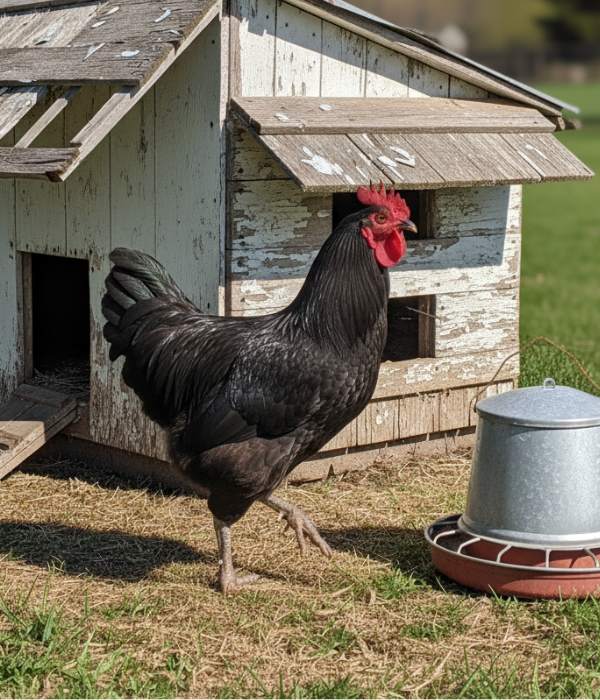
The Jersey Giant is an American heritage breed that people recognize as an all-around triple-purpose bird. Breeders developed it in New Jersey in the late 1800s to replace turkeys on the dinner table.
Jersey Giants grow impressively large: roosters often reach 10–12 pounds and hens about 9–10 pounds at maturity. They come in black, white, and blue (slate-gray) colors, with full plumage and a deep, broad body.
These gentle giants maintain a solid, heavy build – you’ll notice their large size even in winter when they fluff up in a thick coat of feathers.
Though breeders focused on meat, Jersey Giant hens also lay a surprising number of eggs – about 150–200 medium-to-large brown eggs per year.
Hens start laying around five months of age, and their eggs range from deep brown to cream-speckled. The breed’s specialty is its combination of size and calm nature.
Jersey Giants are unusually broody, meaning hens often go on nest and raise chicks on their own. This broodiness is rare among large breeds and adds to your flock’s sustainability.
Temperament-wise, they remain calm and docile; roosters are generally gentle around people and sometimes a bit clumsy around hens due to their size.
These birds live around 6–8 years, and because they grow slowly and naturally, they avoid many health problems common in fast-growing hybrids.
Overall, Jersey Giants give you a very large table bird, good egg production, and even the ability to hatch your own chicks – a true triple-purpose champion.
2. Cubalaya
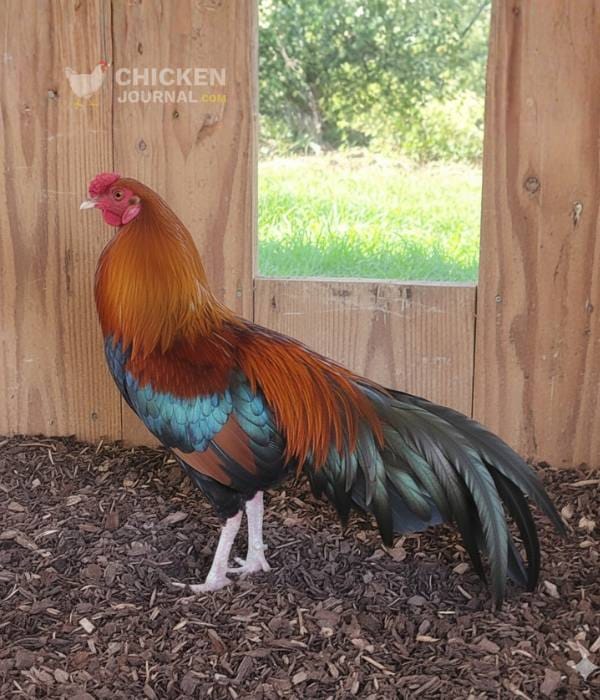
The Cubalaya originated in Cuba in the 1800s, and it is known for its dramatic appearance and triple utility.
This elegant breed has flowing hackle feathers, a proud, horizontal posture, and a distinctive “lobster tail” that points downward at about 20°.
Standard-sized cocks weigh about 5.3 pounds (2.4 kg) and hens about 3.5 pounds (1.6 kg).
In Cuba, breeders created Cubalayas by crossing Malay and Sumatra game birds to produce chickens that were good for meat, eggs, and fighting. The APA recognizes them in three colors: white, black, and black-breasted red.
Cubalayas fill a triple-purpose role in a unique way: they provide meat and eggs, and historically served a purpose in cockfighting (for sport).
However, today, many keepers value them more for eggs and show. Hens lay about 125–175 tinted eggs per year, which are small to medium in size and have a tinted cream color.
These chickens mature slowly (up to three years), but they forage well. They thrive on pasture and feel happiest free-ranging; conversely, confining them can make them restless.
Temperament-wise, Cubalayas are friendly and curious with people but can become aggressive toward other roosters or breeds. They tolerate heat extremely well, making them well-suited for warm climates.
Furthermore, a bonus is their broodiness: hens tend to set and hatch eggs, making them good mothers. If you want a striking bird that lays and also adds exotic flair to your flock, the Cubalaya is a solid choice.
3. American Bresse
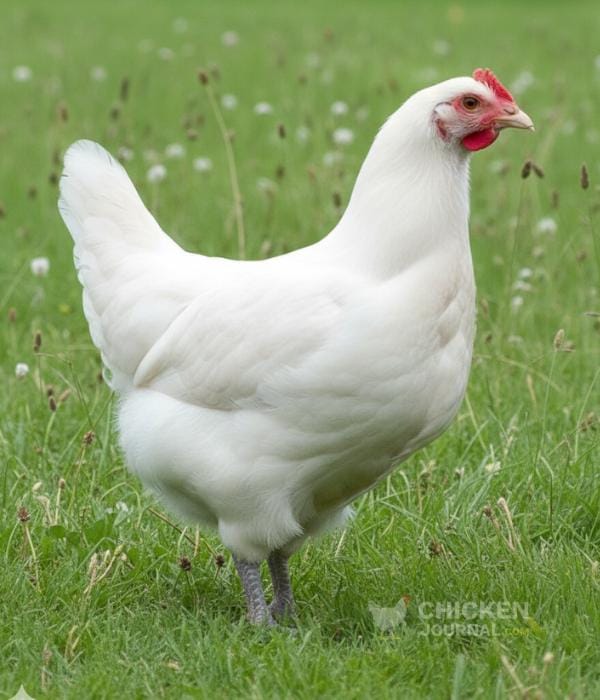
Moving on, the American Bresse is a striking French-origin breed that people prize for flavor, as well as eggs and meat.
True Bresse chickens from France hold fame as a gourmet product, and breeders cultivate the American Bresse from those lines (imported around 2011).
People call them “tricolor birds” because of their colors: bright white feathers, vivid red combs and wattles, and steel-blue legs, echoing the colors of the French flag.
They may also appear in blue, black, splash, or penciled varieties, but the classic look is white with blue legs and red comb.
Although they grow fast, they also serve as excellent layers of large, creamy eggs – often up to 250–270 eggs per year under good care.
These birds reach a substantial size: by 12–15 weeks, they dress out around 4–6 pounds (dressed weight) when keepers raise them properly. Hens weigh around 5–6 pounds, and roosters 7–8 pounds.
In fact, a 10-week free-range program followed by a two-week finishing with good feed and dairy helps produce a highly marbled meat at harvest.
The specialty of the Bresse remains its flavorful meat – chefs often call it “the most delicious chicken” – due to its rich fat marbling.
However, temperament is another plus: American Bresse chickens generally are foragers and fairly friendly, though some can be a bit flighty. The breed tolerates heat and cold.
Roosters have large, upright single combs and bright wattles; hens are calm and attentive mothers. They start laying large cream-colored eggs around 18–20 weeks old.
If you love that red-white-blue look and want a heritage bird with gourmet meat and steady egg production, the American Bresse stands out as a triple-purpose gem.
4. Brahma
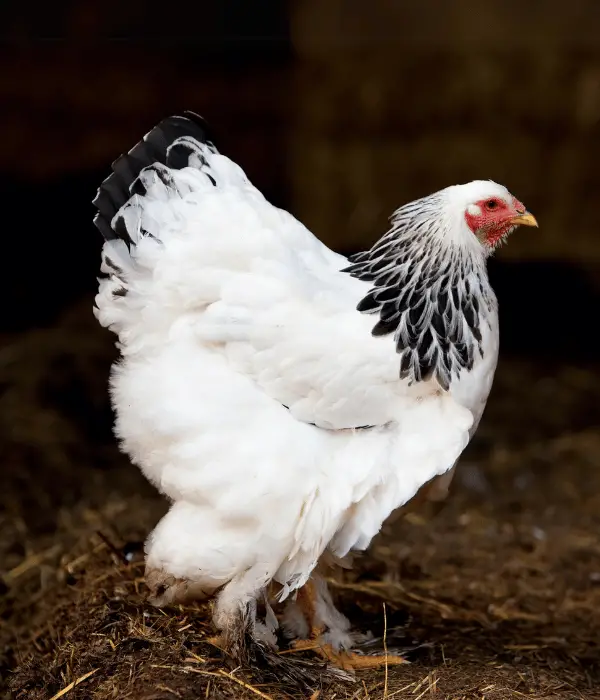
Next, the Brahma is often called the “King of All Poultry” – and for good reason. This American-developed breed (from Asian stock) holds fame for its massive size, sweet temperament, and winter egg-laying.
Mature roosters typically weigh 10–12 pounds and hens 8–10 pounds. They present a solid, imposing body, broad chest, and thick feathering, including feathered legs and feet.
Brahmas come in three color varieties (Light, Dark, and Buff) and have a pea comb. Despite their large, heavy frame, however, Brahmas lay eggs well for their size. They can produce up to 150–200 large brown eggs per year, with many hens laying through winter when others slow down.
In fact, they held the position of a top meat and egg producer in the late 19th–early 20th centuries, and people often raised them as roasters.
Crucially, the breed’s special trait is its ability to thrive in cold weather; their dense feathering and pea comb make them extremely hardy.
Brahma hens also go broody in early summer and make devoted mothers, though you must watch that tiny chicks don’t get trampled under their large feet.
Temperament-wise, Brahmas are calm, docile, and friendly. They are not flighty or aggressive – even roosters generally show gentleness.
Many describe them as cuddly giants. Because of their size, they fit best in spacious coops or runs. You should provide strong footing because their weight can make them prone to joint problems if they grow too fast.
In good conditions, Brahmas live around 8–10 years. Overall, a Brahma gives you a sizeable roaster, steady brown eggs, and a lovable pet-like chicken for your backyard.
5. Orpington
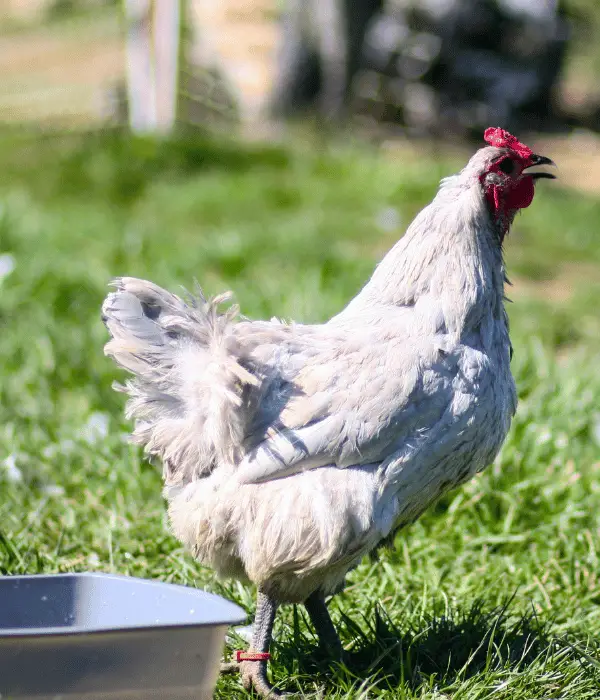
Another classic, Orpingtons are perhaps the quintessential friendly family chicken. Breeders developed this English breed in the 1880s to be dual-purpose (meat and eggs), and they’ve since become beloved as pets and show birds – which gives them a de facto triple-purpose role.
Orpingtons are large, soft-feathered birds with a fluffy, rounded appearance. Hens weigh 6–8 pounds and roosters 8–10 pounds.
They come in many colors (Buff is the most famous, but also Black, Blue, White, Jubilee, Lavender, and others) and people know them for their plush plumage covering their body.
Personality is a highlight: Orpingtons are gentle, calm, and very friendly. They tolerate handling and children well, making them excellent for beginners.
Their calm nature also means they are not high-strung; they do well in confinement or free-range settings. Appearance-wise, they have a deep, broad body, with a short back and small tail, and a single comb.
Many Orpingtons go broody, so they often sit on and hatch eggs – a trait keepers cherish when they want natural hatching.
In terms of production, Orpington hens produce about 150–200 large brown eggs per year. They usually start laying by 5–6 months of age.
They lay consistently and may even lay reasonably through winter. Because breeders developed them to be meaty, their roosters (and hens) have good table size and tender white meat.
Lifespan is about 5–8 years for this breed. In short, Orpingtons give you a steady egg supply, a substantial meat bird, and wonderfully friendly flock members who feel as content being pets or show birds as they are on the range.
6. Australorp
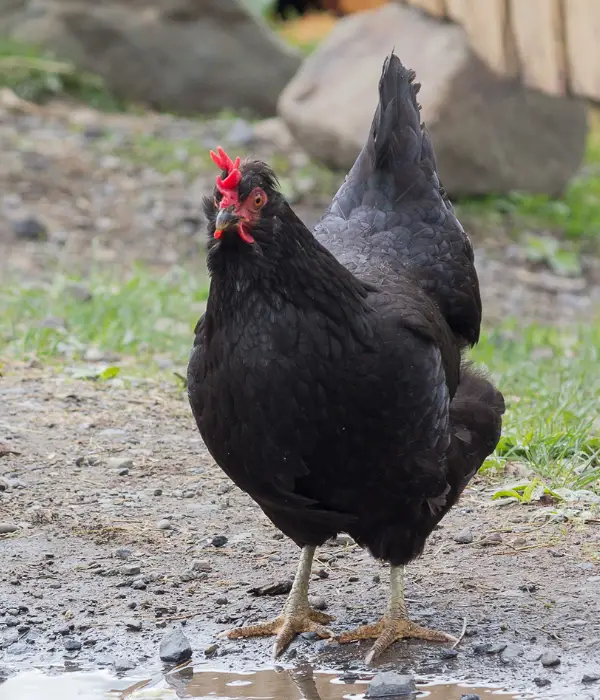
The Australorp hails from Australia, and it essentially represents a Black Orpington crossed with other breeds for superior egg production.
This large, glossy-black bird holds a celebrity status for its record-breaking laying ability and docile nature. Roosters weigh around 8.5 pounds and hens about 6.5 pounds.
They have a single comb and beautiful jet-black plumage; their feathers can have a greenish sheen in sunlight. Australorps only come in black and have clean (unfeathered) legs.
Their specialty is eggs; consequently, even today, a healthy Australorp hen will average 250–300 large, light brown to cream eggs per year.
You can expect about 4–5 eggs per week at peak lay. They do not rank as the meatiest breed by modern standards, but their size gives a fair amount of tender white meat, and they make good roasting birds.
A noteworthy trait is their cold hardiness; being large and dark-feathered, they do very well in winter climates.
Australorps also make excellent mothers. Many become broody and hatch chicks reliably. Finally, in terms of personality, they are calm, friendly, and foragers.
They enjoy free-ranging and will follow you around searching for bugs, but they also stay near the coop, and you find them easy to catch.
Australorps adapt well to different climates (cold or hot) thanks to their good comb size and moderate body. A well-kept Australorp can live 7–9 years.
In summary, this breed makes a triple-threat: a friendly, quiet pet; an outstanding egg producer; and a sizeable, hardy meat bird for the winter table.
7. Wyandotte
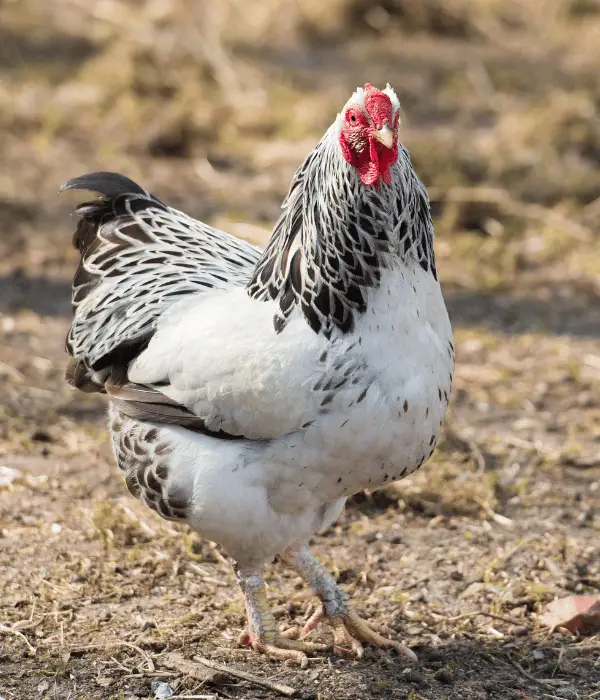
The Wyandotte is an American classic that people know for being both beautiful and practical.
These birds have a rounded, full shape, and people often recognize them by their stunning feather patterns (Silver-Laced and Golden-Laced are very showy varieties, though many colors exist).
Standard roosters weigh about 8–9 pounds and hens 6–7 pounds. They have a rose comb (which makes them frost-hardy) and dense plumage.
Breeders originally developed Wyandottes for dual-purpose use, and they fit right into a triple-purpose role.
As a result, hens lay steadily of medium brown eggs – around 150–200 eggs per year (about 3–4 per week). They usually start laying between 4–6 months old.
These birds are calm and friendly; the Wyandottes show docility and enjoy interacting with people, even children.
They also make good mothers: many will go broody and fiercely protect and teach their chicks how to forage.
For meat, Wyandottes have a plump body and nice white breast meat when they finish around 6–7 pounds. They held the position of mainstay table birds in earlier times.
In addition, another plus is their adaptability: they tolerate confinement and free-ranging alike, and their round bodies help them stay warm in cold climates. Their lifespan reaches 6–12 years under good care.
In short, Wyandottes give you moderately high egg production, dependable brooding, good size for roasting, and a quiet, people-friendly nature – a reliable triple-purpose choice.
8. Sussex (Speckled Sussex)
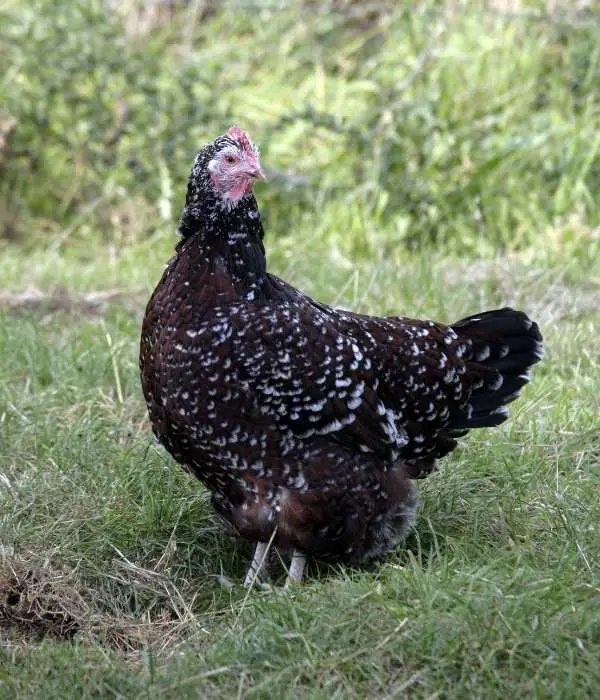
The Sussex chickens (especially the Speckled Sussex variety) are large, striking birds from England.
They feature broad, full bodies and come in several colors; the Speckled Sussex has a mahogany base with white spots and black ticking, which looks very attractive.
Weight-wise, roosters can reach about 9 pounds and hens 7 pounds. They have a single comb and carry their tail at a 45° angle.
This breed historically provided great value for both meat and eggs. Indeed, Sussex hens lay well – often putting out 200–260 large brown eggs per year (roughly 4–5 eggs a week).
They start early and even keep laying in colder months better than many breeds. The Sussex makes “good all-around table bird, famous for flavor,” with tender, juicy meat and a market weight around 6–7.5 pounds.
In terms of temperament, Sussex are docile and friendly. They forage curiously and tend to flock together. Moreover, hens often go broody and prove themselves as excellent mothers.
Historically, Sussex supplied eggs and meat to London in the 19th century and now enjoy a revival for their versatility.
If you want a colorful, hardy bird that lays a lot and makes a fine roast, the Sussex offers an excellent triple-purpose choice.
Their average lifespan reaches about 5–8 years, and during that time they’ll reliably produce eggs and even hatch chicks if you give them a chance.
9. Delaware
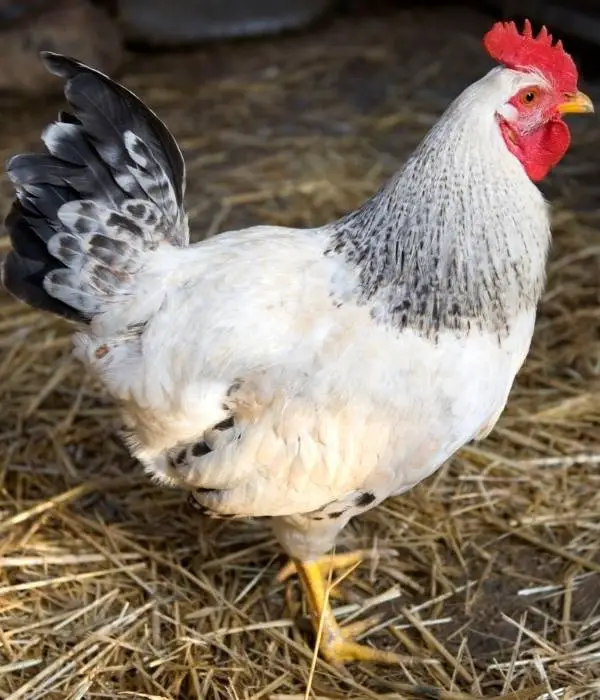
The Delaware breed represents an American dual-purpose bird (now people often appreciate it as ornamental as well).
Breeders developed them in the 1940s on a Delaware hatchery. Appearance-wise, Delawares are mostly white with neat black barring on the neck and tail, giving them a distinct, elegant look.
Hens weigh about 5.5–6.5 pounds and roosters about 7.5–8.5 pounds. Delawares lay well – roughly 250–280 light brown eggs per year (about 4 eggs per week). People know them for laying well and starting early.
Their temperament is calm and friendly (the Tractor Supply guide calls them “mostly calm and friendly, assertive”), and they appear curious and chatty around people.
As a heritage breed, they still retain broodiness, and many hens will set on eggs and raise chicks.
Meat-wise, Delawares show reasonably fast growth and decent body size, though they do not grow as heavy as Orpingtons or Brahmas. Their feathers are white down to pinkish-white skin, producing flavorful white meat.
Therefore, today, people often use them in pasture-based systems for both eggs and meat because of their all-around performance.
They live about 5–8 years. In summary, Delawares give you reliable egg production, manageable meat birds, and a tame, personable character for your flock.
10. Cochin
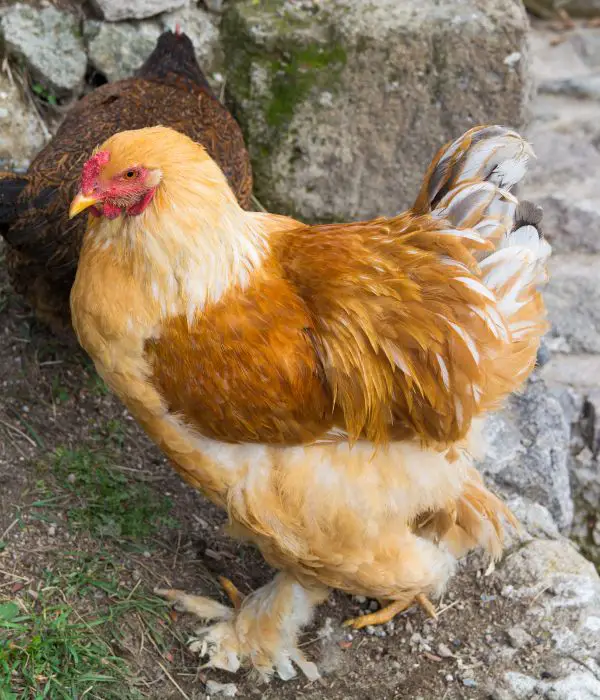
The Cochin is a fluffy, huge chicken from China with a gentle disposition. These birds are so round and feathered that they look like walking cotton balls.
Their plumage covers their legs and feet entirely, making them appear even larger. A standard Cochin rooster can weigh up to 11 pounds and hens around 8.5 pounds.
They come in many colors (Buff, Partridge, Black, White, etc.), and people note them for their profuse, soft feathers.
People once touted Cochins as all-around utility birds. Despite this, nevertheless, they lay about 150–200 medium-to-large brown eggs per year; in modern times keepers value them mainly for exhibition and as pets.
Hens start late (often not laying until 6–8 months) but make up for it with consistent laying thereafter.
The true specialty of Cochins remains their temperament: they are extremely gentle, friendly, and calm. Specifically, in fact, they hold fame for being so docile that they hardly fly and will happily follow you around.
People often call them “lap chickens.” Both hens and roos seldom become aggressive; you can easily keep a Cochin as a pet.
Cochins also breed prolifically as brooders. People consider them among the best hatching and sitting hens in poultry.
Many Cochin hens will hatch multiple broods of chicks (even duck and turkey eggs) each year if you allow them.
However, on the meat side, while Cochins can grow large (they make the best capons at 12–16 months, around 12 pounds), their meat is coarser and less tender than modern meat hybrids.
Today they offer more value for eggs, exhibition, and as parents. With good care, Cochins live about 6–8 years.
If you want a big, remarkably tame and fluffy bird that also contributes to eggs and raising chicks, a Cochin fits that triple-purpose role.
Cochins are “ideal for those looking for a large, impressive chicken with a docile, gentle disposition”.
11. Barred Plymouth Rock
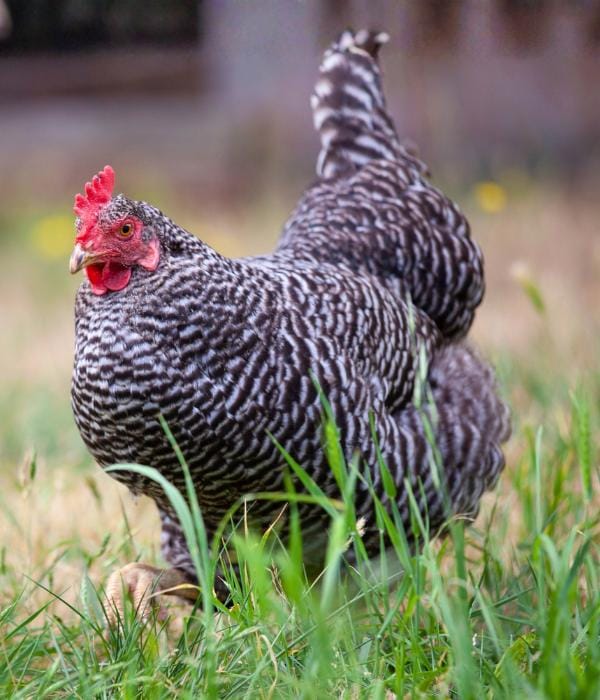
The Barred Plymouth Rock is a backyard staple that people often simply call the Plymouth Rock or Barred Rock.
These chickens have a striking black-and-white barred plumage (the name “Barred” comes from this pattern).
They have a sturdy, broad body and a single comb. Roosters weigh about 9–10 pounds and hens 7–8 pounds.
Barred Rocks make a classic dual-purpose bird, and they also excel as friendly pets. Furthermore, hens lay around 200 large brown eggs per year.
They lay reliably through much of the year and often lay well into winter. Historically, breeders even developed Barred Rocks specially for high production in the early 20th century, providing both meat and eggs for American farms.
In temperament, Barred Rocks are calm, friendly, and easy to handle. They do well in small backyard flocks and around children, making them beginner-friendly.
They have a long lifespan (10–12 years) and, being a heritage breed, they show an inclination to go broody. A broody Barred Rock can become protective of her chicks, and people respect her for being a good mother.
As meat birds, older heritage strains of Plymouth Rocks provide good roasters at around 7–8 pounds. Modern production strains may prove slightly leaner but still yield decent, flavorful meat.
Ultimately, the Barred Plymouth Rock gives you solid egg production, a forgiving and family-friendly nature, and a moderate roasting bird – all wrapped up in an attractive striped plumage.
FAQs
Q: What does “triple-purpose” mean for chicken breeds?
A: A triple-purpose chicken breed offers value for three key uses: egg production, meat yield, and often an additional trait like brooding or friendliness. In practice, this usually means the birds lay a fair number of eggs, grow to a decent size for roasting, and have a calm or maternal personality that also makes them good pets or mothers.
Q: How many eggs do triple-purpose chickens lay?
A: It depends on the breed, but most listed triple-purpose breeds lay at least 150 eggs per year, with many hitting 200 or more under good conditions. For example, Australorps can average 250+ eggs/year, American Bresse around 250–270, and Sussex hens even 200–260. These birds do not focus as heavily on eggs as Leghorns, but they lay consistently and often through winter.
Q: Are these breeds good for beginners and families?
A: Yes, most triple-purpose breeds maintain friendly, docile temperaments. Breeds like Jersey Giant, Orpington, Australorp, Cochin and Barred Rock are known to be very calm and easy to handle. They tolerate children well and are not flighty or aggressive. Just give them enough space and they’ll become part of the family.
Q: Can triple-purpose chickens go broody?
A: Many of the breeds listed show a tendency toward broodiness. For example, Jersey Giant, Orpington, Cochin, and Barred Rock often sit on eggs and hatch them out. If you want to hatch your own chicks naturally, these breeds make great choices. However, some (like the American Bresse) breeders develop more for nonstop laying, and they may brood less.
Q: What should I feed triple-purpose breeds?
A: Feed them the same balanced diet as other chickens: a quality layer feed for hens, starter/grower feed for chicks, and extra protein for developing meat birds if you’re raising roasters. Because many of these breeds are large, they may need more feed per bird than lighter breeds. Supplementing with kitchen scraps and allowing foraging will help you meet their higher energy needs. Always provide fresh water and oyster shell for calcium if they are laying.
Q: How long do these chickens live?
A: With good care, most of these heritage breeds live around 6–10 years. For example, Jersey Giants and Barred Rocks often live into their early teens (10–12 years). Average lifespans mentioned include 5–8 years for Orpingtons, 6–12 for Wyandottes, and around 8–10 for Brahmas. Proper nutrition and shelter help them reach their maximum lifespan.
Q: Which triple-purpose breed is best if I want the most eggs?
A: If egg count is your top priority, consider Australorps (famed for world-record laying), Speckled Sussex, or American Bresse – these can lay over 250 eggs per year. Delaware chickens also offer exceptional laying (often 250–280 eggs annually). These breeds balance good egg output with meat size and gentle temperament.
Q: Do I need a separate rooster for meat?
A: No, you do not need roosters to get meat. All of the above breeds can provide meat, whether you raise them as cockerels or capons. Roosters will grow larger, but you can process young pullets or cockerels if you want. However, having a rooster can help you maintain a flock naturally and also ensures chicks if you want to breed. (Always follow local regulations about keeping roosters.
Conclusion
By choosing any of these triple-purpose breeds, therefore, you set up your flock for multi-faceted success. Each breed above offers a balance of good egg yield, respectable meat size, and a pleasing temperament or specialty.
As you plan your backyard flock, think about which traits matter most to you. If you want winter layers and massive size, a Brahma or Jersey Giant might prove ideal.
For gourmet flavor and patriotic colors, American Bresse fits the bill. If you love broodiness and brooding chicks, Cochin or Orpington are superb.
All these breeds will lay eggs for breakfast, grow to fill your dinner plate, and also give you a friendly, interesting hen or rooster in the coop.
Remember to provide any breed with clean water, balanced feed, and safe shelter so their triple-purpose potential can truly shine.
